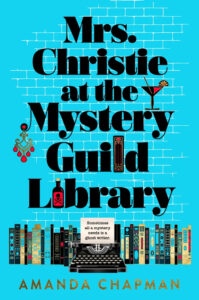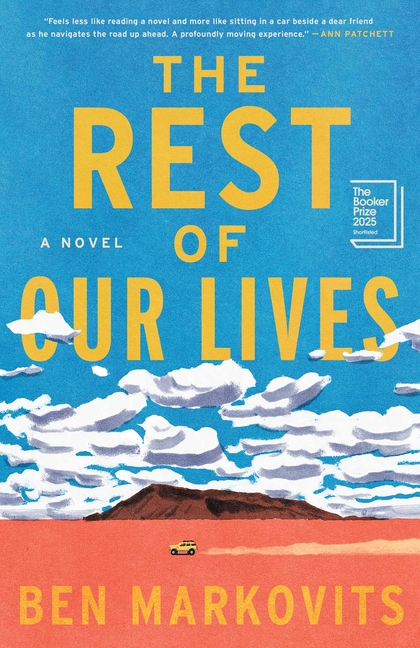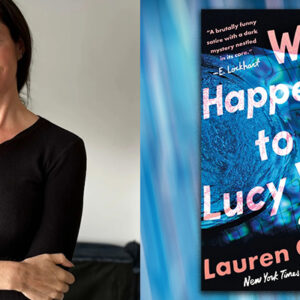Let me begin by saying that when it comes to the supernatural, I am a sort-of skeptic/sort-of believer. I see myself in Mary Oliver’s poem “Angels”: “The whole business of what’s reality and what isn’t has never been solved and probably never will be/ So I don’t care to be too definite about anything./ I have a lot of edges called Perhaps and almost nothing you can call Certainty.”
So when I began writing Mrs. Christie at the Guild Library—in which a (highly skeptical) book conservator named Tory Van Dyne and a woman claiming to be Agatha Christie on holiday from the Great Beyond join forces to catch a killer—I found myself wanting to explore those “edges call Perhaps.”
Perhaps, I reasoned, there is a Great Beyond. And perhaps the Queen of Crime would be bored to death (pun fully intended) with no crimes to solve there. And perhaps on some rainy September evening a book conservator named Tory Van Dyne might discover a woman in the library’s Christie Room who would calmly introduce herself as the Queen of Crime, politely request a cocktail, and announce she’s there to help solve a murder—that has not yet happened.
Perhaps Tory would be, in the beginning at least, highly skeptical, and would assume that what she’s dealing with is a slightly nutty Christie fangirl. The problem, of course, is that when Tory shakes the proffered hand of the woman seated in the armchair, her visitor’s grip would be firm and warm and real. And she would bear an uncanny resemblance to the famous photo of Agatha Christie seated at a desk signing copies of her latest whodunit, looking a bit worriedly at two crooked stacks of books piled perilously high on either side of her.
Perhaps over time Tory would become less skeptical, finally agreeing with her librarian friend Adrian that perhaps certain mysteries are sometimes just, well, mysterious. Would they really try to prove to themselves that Mrs. So-Called Christie was some kind of otherworldly manifestation of the Queen of Crime on holiday from the Eternity come to the Agatha Christie Room to drink cocktails to no noticeable effect except to always ask the right questions to help them find a killer? No, they would not. For the simple reason that if they did, their heads would explode.
And so, by exploring these “edges called Perhaps,” Mrs. Christie in the Mystery Guild Library joined the ranks of what I call the subtly paranormal mystery, in which little more is asked of the skeptical reader except a certain suspension of disbelief. Louise Penny’s Inspector Gamache mysteries—set in the mysterious and charming village of Three Pines (which, as it happens, appears on no map or GPS)—are a wonderful example of this. And Tana French’s police procedurals often have a certain ambiguously supernatural tone, most clearly in her downright spooky The Secret Place.
There are others along those lines, some more equivocal about the role of the supernatural in the story than others, but none in my view is more fun than Agatha Christie’s own The Mysterious Mister Quin, in which the otherworldly Harley Quin asks of his friend Satterthwaite, “You believe in a life after death, do you not? And who are you to say that the same wishes, the same desires, may not operate in that other life?”
Perhaps, in the case of Mrs. Christie at the Mystery Guild Library, they do…
To help you make up your own mind, below are five volumes that have convinced me that, as Mary Oliver concludes in “Angels,” “I don’t care how many angels can dance on the head of a pin./It’s enough to know that for some people they exist, and that they dance.”

Still Life by Louise Penny
In this first of Penny’s Chief Inspector Armand Gamache mysteries, the town of Three Pines is as much a character as any of the players in the drama. “Like Narnia,” Penny writes, “it was generally found unexpectedly and with a degree of surprise… Anyone fortunate enough to find it once usually found their way back.” And many of us have been doing exactly that for some twenty years.
In Still Life, Gamache is called to the suspicious death in the village of Jane Neal, a much-loved retired schoolteacher who has been found dead in the woods. The locals want desperately to believe it’s a tragic hunting accident, but Gamache suspects that she has died at the hands of someone, or something, much more sinister than a careless bowhunter.
In the course of the investigation, we and Gamache come to know the renowned artist Clara Morrow, the wonderfully foul-mouthed poet Ruth Zardo, a former psychologist turned bookstore owner Myrna Landers, and bistro hosts, Gabri Dubeau and Olivier Brulé. But we also come to know Gamache – empathetic but clear-sighted, intuitive but empirical. Gamache is not in any way a supernatural force. What he is, is a man charged with bringing a mysterious peace back to Three Pines.
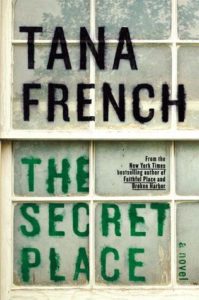
The Secret Place by Tana French
This fifth book in Tana French’s superb Dublin Murder Squad series takes place in St. Kilda’s, a posh girl’s boarding school where a year earlier a boy was found murdered in a case that was never solved. A year after Chris Harper’s body was found, the investigation is cold—until a St. Kilda’s girl brings Detective Stephen Moran a photo and a note she’s found on the school’s “Secret Place” bulletin board, with the words “I KNOW WHO KILLED HIM.” Moran is thrilled to be assigned to work with Senior Detective Antoinette Conway when the case is reopened. But he is hard-pressed to see his way through the weird and claustrophobic maze of an almost-too-closely-knit group of friends, their rival clique, and the tangle of relationships that bound them all to the murdered boy.
The structure of the book—told over the course of one day, as each of the girls involved is interviewed by Moran and Conway and flashbacks provide disturbing glimpses of the past—is masterful. The girls are convinced of their shared ability to lift objects and manipulate lights with their minds, and French, a master of ambiguity, leaves it up to the reader to decide: Were these genuine supernatural occurrences or shared psychological hallucinations? Or something more tangible? Either way, it’s downright eerie.

The Shape of Night by Tess Gerritsen
Eerie doesn’t even begin to describe Tess Gerritsen’s The Shape of Night. As familiar as the “sea-captain ghost” trope may seem, this gothic thriller/mystery is no The Ghost and Mrs. Muir. This is a sexy, dark investigation of secrets, obsession, and murder.
In an attempt to leave a terrible tragedy—and her own guilt—behind, cookbook writer Ava Collette escapes to small-town Maine, where she rents Brodie’s Watch, an isolated mansion rumored by the locals to be haunted by the ghost of a certain Captain Jeremiah Brodie. Unsurprisingly, the ghostly Captain Brodie wastes no time greeting—and bedding—his new tenant. What the locals don’t tell Ava, though, is that the women who have lived in Brodie’s Watch tended to meet a terrible end. Is Captain Brodie behind the deaths? Or are we looking at a killer who is all too human—and may be looking even now for a new victim?
Told in classic unreliable narrator mode—Ava has a pretty significant love affair with alcohol as well as with Captain Brodie—The Shape of Night leaves the reader—and Ava—wondering to what extent the supernatural has been at work. And whether, in the long run, that even matters.
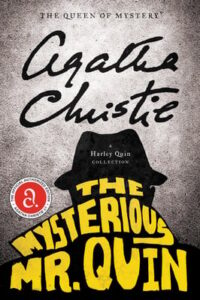
The Mysterious Mr. Quin by Agatha Christie
This short story collection from the Queen of rationality (witness Hercule Poirot and Miss Jane Marple) is remarkable for the unmistakably supernatural character of Mr. Harly Quin. In each story, Quin appears (and disappears) almost magically to help his friend, the elderly socialite Mr. Satterthwaite, solve earthly problems of love and death.
Inspired by Harlequin, the Commedia dell’Arte character often depicted with the ability to appear and disappear at will, Harley Quin may be an ordinary man who simply inspires Mr. Satterthwaite to act as a detective, bringing together couples, and solving crimes. Or perhaps, one could be forgiven for thinking, he is an ambassador between the worlds of the living and the dead, righting wrongs and ensuring that love reigns.
And should we have any questions as to Mrs. Christie’s own view of Mr. Quin, witness these final lines of perhaps the most direct story in the collection, “The Man From the Sea,” in which Satterthwaite offers to walk back to the hotel with Mr. Quin:
But Mr. Quin shook his head.
“No,” he said. “I shall go back the way I came.”
When Mr. Satterthwaite looked back over his shoulder, he saw his friend walking towards the edge of the cliff.
***


